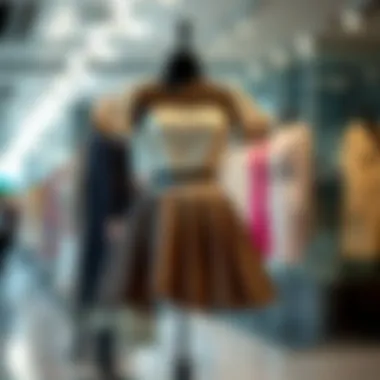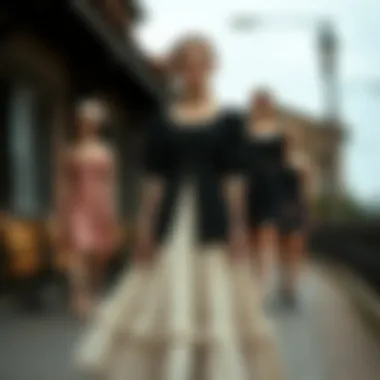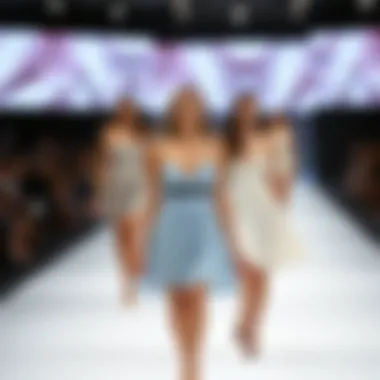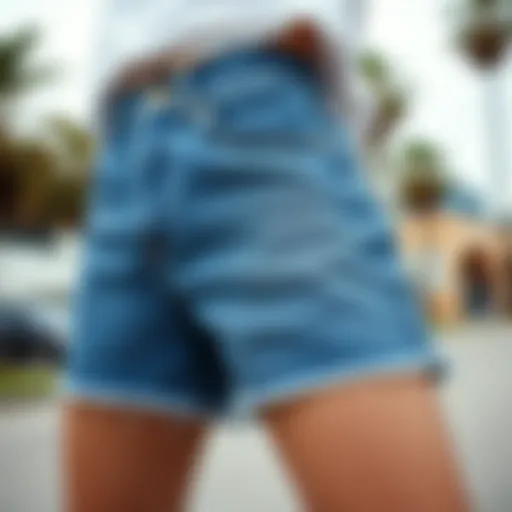The Allure of Short Dresses: A Comprehensive Exploration


Intro
Short dresses have an unmistakable ability to captivate. From sun-drenched picnics to late-night gatherings, they offer a blend of style and comfort. Their history runs deep, intertwined with social changes and evolving fashion standards. When we peer into the allure of short dresses, we witness how they've transformed and adapted over the years, remaining a steadfast choice for many.
In this exploration, we will navigate the multifaceted nature of short dresses. We will kick things off by looking into current fashion trends and how they shape our view on short dresses today. Then, we will transition to style guides that detail how to choose the right dress for various occasions and how accessories can elevate any look.
Fashion Trends
Current Seasonal Trends
Each season brings its own flavor, and short dresses are no exception. In spring and summer, vibrant colors and floral patterns reign supreme, reflecting the energetic spirit of the warmer months. You might notice sheer fabrics making a statement as they sway gently with movement. As autumn rolls around, earth tones become the star of the show, marked with deep burgundies, burnt oranges, and muted greens. These shades encapsulate the essence of fall while still providing the comfort and ease of a short dress.
On the runway, designers frequently showcase how short dresses can adapt to changing trends. Wavy hemlines, asymmetrical cuts, and layered designs often catch the eye. It’s a refreshing evolution that speaks to both elegance and modernity. However, it’s essential to keep an eye on fabrics. Cotton and linen often dominate in summertime, while heavier textiles like wool and velvet find their way into cooler months.
Influential Designers and Their Impact
The world of fashion is profoundly shaped by designers who dare to push boundaries. Iconic names like Coco Chanel played a pivotal role in popularizing shorter lengths in the 1920s, paving the way for future generations. Fast forward to today, and designers like Stella McCartney and Alexander Wang continue to inspire with their unique takes on short dresses. This mix of heritage and contemporary vision sketches the modern landscape.
But it's not just about the big names; emerging designers are also making waves. Many focus on sustainable practices, crafting short dresses from eco-friendly materials. This dual emphasis on trend and sustainability speaks to a growing consciousness in fashion, resonating especially with the younger demographic.
"Fashion is about change, but also about remembering who we are and where we came from."
As we unravel the layers of short dresses, it becomes clear that they are not merely a garment; they represent cultural shifts, personal expression, and an evolving world of style. In the following sections, we will further explore how to navigate the myriad options available, ensuring that every enthusiast finds their perfect fit for any occasion.
Historical Context of Short Dresses
The evolution of short dresses plays a crucial role in understanding their allure and the transformations that clothing undergoes over time. The journey of this garment reflects not just changes in fashion, but also varying cultural norms, societal attitudes, and technological advancements. Delving into the historical context of short dresses lays the groundwork for appreciating the modern interpretations and innovations surrounding this piece of clothing. It highlights how short dresses have been at the epicenter of style revolutions and how they've adapted to the desires and needs of different eras.
Evolution Through the Decades
Short dresses have witnessed numerous metamorphoses from their early days to the contemporary styles we see today. In the 1920s, for instance, flapper dresses took the fashion scene by storm, empowering women to break free from restrictive garments. These dresses were often knee-length or shorter, embodying a spirit of freedom and rebellion against the traditional long skirts of the Victorian era. The playful nature of the flapper dress was a direct reflection of the social changes happening around the globe – think jazz music, speakeasies, and the emergence of a more independent woman.
Fast forward to the 1960s, and the miniskirt emerged, revolutionizing women's fashion once again. Designers like Mary Quant popularized this daring silhouette, which could be seen on runways and in street style alike. The miniskirt wasn't just a trend; it represented a cultural shift towards liberation and self-expression. It was a bold affirmation of femininity and youth.
During the following decades, short dresses continued to evolve. The 1980s showcased bright colors and exaggerated silhouettes, influenced heavily by pop culture icons. By the time the 1990s rolled around, grunge was redefined to include even the casual dressing down of short dresses, merging comfort with chic minimalism.
As we entered the 2000s, the influence of technology and globalization began to shape fashion in unprecedented ways. The rise of fast fashion meant that arbitrary patterns could take hold of society too quickly, with designs popping up and fading just as fast. Today’s short dresses are a myriad of styles, often layered and inspired by years of history, each piece telling a fragment of the greater narrative.
Cultural Icons Influencing Trends
Cultural icons have often played a pivotal role in shaping the fashion landscape and, naturally, the short dress has not been immune to this influence. Icons such as Audrey Hepburn, with her quintessential little black dress in Breakfast at Tiffany’s, brought a sense of timeless elegance to short dresses that is still revered today. Her style has become synonymous with class and sophistication, paving the way for future designers to draw inspiration from her looks.
Moreover, modern icons like Beyoncé and Taylor Swift have wielded their influence to redefine the short dress’s appeal. With performances and public appearances styled in captivating short dresses, they introduce new patterns, textures, and innovations. Their visibility and impact on social media amplify this reach, making their style choices trend almost overnight.
Even athletes, like Serena Williams, have made their mark on the short dress scene. Their unique blend of functionality and flair showcases just how adaptable this style can be, proving that short dresses can be the perfect amalgamation of sportiness and fashion.
To sum up, the historical context of short dresses reveals an ongoing dialogue between fashion and society’s ethos. It not only illustrates how short dresses have become a staple in wardrobes but also reflects a broader spectrum of cultural shifts and personal expression. The evolution through decades and the impact of cultural icons have propelled short dresses into a realm where they serve as both a canvas for individual style and a reflection of collective ideals.
Modern Interpretations of Short Dresses
The realm of short dresses is continuously evolving, making it a pivotal topic in fashion discussions today. Modern interpretations showcase not only style transformations but also the ways in which these garments reflect societal shifts and values. Whether it's through new silhouettes or fresh cultural lenses, short dresses have adapted and thrived, resonating with individuals on personal and communal levels.
Defined by the Latest Fashion Weeks
Fashion weeks, perhaps the heartbeat of the fashion industry, play a crucial role in defining modern short dress trends. Each season, designers take to the runway to showcase their interpretations, often distilling current societal narratives into visual designs. For instance, the Spring/Summer Collection of 2023 featured bold patterns and asymmetrical cuts, creating a juxtaposition of playfulness and sophistication. This representation not only appeals to younger generations but also speaks to a growing desire for individuality within fashion.
Moreover, notable fashion houses like Chanel and Dior have introduced short dresses with layered textures, incorporating fabrics like tulle and organza. This trend underscores a shift towards more experimental styles that allow for self-expression and creativity. As attendees leave these shows, they carry forward the essence of what they witness, inevitably filtering into everyday wardrobe choices, paving the way for the modern girl-next-door to fashionably strut in her own short dress.
"Fashion is not something that exists in dresses only. Fashion is in the sky, in the street; fashion has to do with ideas, the way we live, what is happening." - Coco Chanel
Influence of Social Media on Popular Design
Alongside traditional platforms, social media has transformed how trends emerge and gain traction. Fashion influencers and everyday users alike leverage platforms like Instagram and TikTok to showcase their unique takes on short dresses. Trends can go viral overnight, with hashtags like #ShortDressSeason and #DressUpChallenge serving as cultural signposts for the evolving style. For instance, the resurgence of the mini-dress in vibrant hues can be traced back to popular TikTok challenges that invited users to remix their favorite pieces in creative ways.
Additionally, the accessibility of content-sharing platforms allows even a novice to become a tastemaker. Users experimenting with DIY alterations can spark wider trends, broadening the definition of what comprises a short dress. A simple change like adding lace trim or mismatching colors can elevate a basic design, reflecting an individual's personality against a backdrop of global inspiration.
In summary, the contemporary landscape of short dresses reveals a rich tapestry woven from influences seen in fashion weeks and amplified through social media. This convergence shapes not only what short dresses look like but also how they are perceived and valued by wearers today. Given the dynamic interchange of trends and personal expression, short dresses remain a fascinating focal point in dressing, embodying both cultural commentary and individual storytelling.
Useful links:


- Wikipedia on Fashion Trends
- Britannica - Fashion History
- Reddit - Fashion Tips
- Instagram Fashion
- TikTok Fashion
Fabric Choices and Their Impact
The fabric selection for short dresses significantly influences both their aesthetic appeal and practicality. Choosing the right material can enhance comfort, alter the drape and silhouette, and affect the garment's longevity. Considering different fabrics adds a layer of complexity to the style of a short dress, making it imperative for designers and fashion enthusiasts to be discerning. Selecting fabrics that suit the season, occasion, and personal taste is key to creating a dress that not only looks good but feels great, too.
In this section, we will explore two pivotal fabric categories that cater to different climatic and styling needs. By understanding their properties, readers can better appreciate how each material impacts the overall feel and appearance of short dresses.
Lightweight Materials for Summer Styles
Summer is synonymous with light, airy fabrics that allow the skin to breathe, making lightweight materials a popular choice for short dresses during warm months. Fabrics such as cotton, linen, and chiffon reign supreme in the sweltering heat due to their sheer comfort.
- Cotton: A classic fabric, cotton is not only breathable but also easily customizable. It holds prints and colors beautifully, making it versatile for various styles, from casual to semi-formal. Its inherent softness feels pleasant against the skin, ideal for those hot summer afternoons.
- Linen: Renowned for its linen texture, this fabric has moisture-wicking properties that help keep wearers cool. Moreover, it creates a unique, laid-back aesthetic with its natural crinkles, giving a relaxed vibe—perfect for summer outings or beach getaways.
- Chiffon: For those looking to add a touch of elegance without sacrificing comfort, chiffon is an excellent option. This sheer, lightweight fabric flows effortlessly, creating a graceful silhouette. Whether layered over a lining or worn as is, chiffon short dresses sway beautifully with movement, making them ideal for summer parties or evening strolls.
Choosing lightweight materials not only aligns with seasonal trends but also enhances the overall experience of wearing a short dress.
Layering Techniques for Transitional Wear
As the seasons shift, layering becomes essential for those who want to maintain the short dress's charm. The right layering can transition a short dress from a sunny day out to a cooler evening effortlessly. Here are some effective layering techniques:
- Denim Jackets: A classic choice, a denim jacket pairs remarkably well with short dresses. It adds a casual edge and provides warmth during chilly evenings. Opt for a fitted or slightly oversized version, depending on the desired look.
- Long Sleeves Underneath: Adding a fitted long-sleeve top beneath a short dress harmonizes warmth with style for transitional weather. This look is chic and pragmatic, perfect for fall or spring when temperatures fluctuate.
- Tights and Leggings: When the chill sets in, consider pairing a dress with tights or leggings. This layered approach ensures comfort while allowing for playful patterns or colors, allowing one’s personality to shine through even as the temperatures drop.
Layering techniques not only maximize a short dress's potential but also adapt its style for a variety of occasions. By thoughtfully combining fabrics and layers, individuals can create outfits that are as versatile as they are stylish. These techniques reinforce the idea that short dresses, when paired with the appropriate materials and layering strategies, can be appropriate for an array of environments, from casual brunches to more formal events.
"Fabric choices dramatically shape the comfort and style of short dresses. Understanding the interplay between fabric and form helps in curating a flawless wardrobe."
Styling Short Dresses for Different Occasions
When it comes to short dresses, adapting them to various situations can be the key to showcasing their true versatility. Not every short dress fits the mold of casual wear or formal attire, and understanding how to style them for different occasions is crucial. This section aims to illuminate the details that help transform a simple short dress into an outfit suitable for almost any event.
Creating Casual Looks
Casual settings call for a relaxed vibe, and short dresses are often the unsung heroes of this particular aesthetic. The right styling can elevate a dress into something effortlessly chic, perfect for picnics in the park or brunch with friends.
Footwear Options
The choice of footwear plays an integral role in crafting casual looks with short dresses. Sneakers, for instance, can be a game changer. Their comfort and modern appeal make them an excellent choice, especially when paired with light cotton or linen dresses. Think about a brightly colored sneaker to compliment a neutral-toned dress, creating a playful yet stylish look.
On the other hand, flat sandals bring a laid-back sophistication to casual wear. They offer breathable comfort, ideal for warm weather. Consider options with embellishments like beads or charms to add a bit of flair.
However, it's important to note that not all footwear options translate well for every occasion; for instance, overly rugged sandals could detract from the dress’s femininity.
“The right shoes can make or break an ensemble, especially with the carefree charm of a short dress.”
Accessorizing for Informal Settings
When it comes to accessorizing, keeping things light and breezy is the way to go. Think oversized sunglasses and a casual tote to round out your outfit—these pieces can lend an air of effortless chic. A simple canvas bag is not just practical; it avoids overwhelming the dress.
Additionally, jewelry should be minimal yet striking—dainty necklaces or hoop earrings work beautifully without overshadowing the outfit. Another option is a lightweight scarf, which can lend a pop of color and personality, while also doubling as a wrap during cooler evenings.
Crucially, one should avoid over-accessorizing; the goal is to accentuate the dress, not to distract from it.
Dressing Up for Formal Events
Contrary to popular belief, short dresses can also shine in more formal contexts. With the right tweaks, these versatile pieces can exude sophistication and elegance simply by adjusting accessories and styling.
Choosing the Right Accessories
In formal environments, accessories become the bridge between casual and refined. Opting for statement pieces, like a bold clutch or elegant heels, can elevate a simple short dress into something standout. Metallic tones are particularly popular for formal wear, as they tend to catch the light beautifully.
When it comes to jewelry, think about wearing a pair of chandelier earrings or a coordinating bracelet that ties everything together. These highlights draw the eye upward, framing the face and enhancing one’s overall appearance. The key here is in striking the perfect balance—too much shimmer can overshadow the inherent beauty of the dress itself.
Makeup and Hair Considerations
Makeup and hair play a significant role in completing a formal short dress look. A sleek style, such as a low bun or soft waves, can add sophistication. Similarly, a polished makeup look with defined eyes and a bold lip can enhance the outfit's elegance.
It's crucial not to veer too far into overly dramatic territory; the idea is to complement the dress and make the wearer feel confident. Thus, opting for subtle but professionall looks can help to retain the focus on the dress itself while allowing the wearer’s personality to shine through.
The Trending Colors and Patterns
When diving into the fashion realm, the significance of colors and patterns cannot be brushed under the rug. They play a crucial role in projecting one's personality and mood. In the world of short dresses, the right combination of hues and motifs can elevate a simple garment into a true fashion statement. This section expands upon how current trends not only reflect the season but also resonate with individual expression through vibrant palettes and unique designs.


Seasonal Color Palettes
Colors have a language of their own, and each season whispers different tones that resonate with the time of year. For instance, spring tends to bloom with pastel shades like soft pinks and baby blues, which convey sensitivity and freshness. Conversely, summer heats things up with fiery reds, bright yellows, and bold greens, creating an aura of joy and vibrancy.
- Autumn often brings earthy tones like rust, olive green, and burgundy—capturing the lovely fall foliage and evoking a sense of warmth.
- Winter, however, might shine with deep jewel tones such as sapphire and emerald, or frosty whites and silvers, reflecting the season's elegance and stark beauty.
These seasonal palettes remain vital in fashion choices. They determine what items fly off the shelves and transform everyday attire into outfits that speak to current sentiments. Especially in short dresses, selecting a color aligned with the season helps the wearers connect with the environment while showcasing their personal style.
Utilizing Patterns to Express Personal Style
Patterns breathe life into short dresses. From polka dots to floral prints, these elements aren't merely decorative—they tell a story. A short dress adorned with floral designs may evoke feelings of carefree days spent in a sunlit garden, while a geometric pattern could signify a bold, modern personality. Choosing the right design can elevate an ensemble to new heights.
- Stripes can give an illusion of elongation, while also providing a casual edge to any outfit.
- Checks are making a comeback, often being styled in playful yet sophisticated ways, adding an element of nostalgia.
- Animal prints, once considered daring, are now staples which bring out an assertive vibe among wearers.
Using patterns effectively is about balance. Mixing prints can be a delicate art, often requiring a nuanced approach to maintain harmony in an outfit. Understanding how to pair a patterned short dress with complementary accessories, such as a solid handbag or minimalist jewelry, allows for showcasing one's personality without overwhelming the observer.
"Fashion is the armor to survive the reality of everyday life." - Bill Cunningham
By understanding trends in color and pattern, fashion enthusiasts can reshape how they present themselves through short dresses. It's not just about following rules; it's about setting them. Finding colors and patterns that resonate personally transforms a short dress into a canvas for self-expression.
Cultural Perspectives on Short Dresses
Exploring cultural perspectives on short dresses is pivotal in understanding their multifaceted appeal. These garments don’t just serve an aesthetic purpose; they carry significant cultural weight. When women don short dresses, they often express themselves, showcase their individuality, and tap into shared trends that resonate across different societies. This section aims to delve into the regional variations in how short dresses are perceived and the intricate relationship between body image and confidence that they evoke.
Regional Variations and Adaptations
Short dresses are not one-size-fits-all; their meaning and style adjust based on cultural context. For instance, in the vibrant streets of Tokyo, short dresses often merge contemporary fashion with traditional influences, leading to striking ensembles that reflect both modernity and heritage. Alternatively, in Mediterranean cultures, short dresses are synonymous with leisure and warmth, often seen at beachside cafes or during festive gatherings.
- In the United States, short dresses are a staple for everyday wear, often accessorized in a myriad of ways. The festival culture, as seen in events like Coachella, further embellishes their significance, where each dress tells a story.
- In Middle Eastern nations, however, the approach can be quite different. Here, short dresses may be paired with layers to respect cultural norms, merging Western influences with local customs. The modesty of silhouette adapts to fit societal expectations while still allowing for personalization and expression.
These regional variations highlight the adaptability of short dresses and their ability to resonate within diverse cultural backdrops, making them a global garment.
Implications of Body Image and Confidence
Body image and confidence play a crucial role in how short dresses are embraced or avoided by different individuals. In many cultures, there’s an undeniable link between the media portrayal of beauty, the shape of short dresses, and how women perceive their bodies. When a woman steps out in a short dress, it's often imbued with layers of meaning about self-acceptance and personal empowerment.
- Positive Impacts:
Short dresses can promote a sense of confidence among women of all shapes and sizes. Wearing a dress that feels good can boost one's mood, making one feel more attractive and self-assured. Many women find that the right fit enhances their natural beauty, allowing them to embrace their unique bodies and challenge societal standards. - Challenges:
Conversely, the societal pressure to conform can lead to discomfort for some, who might feel judged or scrutinized. The fear of body shaming can deter women from wearing short dresses, even when they wish to express their individuality. It's vital to foster an environment where every body is celebrated, regardless of size or shape.
Ultimately, the connection between short dresses and body image reflects broader societal attitudes towards femininity. As trends continue to evolve, it’s crucial for fashion to encourage diversity, making everyone feel welcome in their own skin.
"Fashion is not just about clothes. It's a testament to who we are and how we want to be perceived."
The cultural perspectives surrounding short dresses encapsulate a journey of adaptation and identity. As we continue to explore and embrace short dresses in various contexts, it's essential to advocate for a narrative that empowers every woman to wear what makes her feel beautiful and confident.
Sustainability in Fashion Choices
Sustainability in fashion is more than just a trendy buzzword; it’s an essential consideration for today’s consumers, especially when it comes to short dresses. As the industry continues to face scrutiny over its environmental impact, many are turning to eco-friendly practices and products. Understanding sustainability in the context of short dresses can enlighten fashion enthusiasts on how to make thoughtful choices that not only flatter their figure but also care for the planet.
The importance of sustainable fashion resonates well with a growing segment of shoppers who prioritize ethical sourcing and minimal waste. Short dresses, while often associated with fun and carefree styles, can embody a much deeper commitment to sustainability. From the fibers used to the lifecycle of the garment, every detail matters. Choosing sustainable short dresses means opting for materials that are less harmful to the environment, thereby making a choice that reflects a broader impact.
In an industry that is notorious for generating waste, the shift towards sustainability has ignited a passion for conscious consumption among consumers. This movement encourages the adoption of practices that protect natural resources, reduce carbon footprints, and endorse fair labor conditions. With this awareness, the allure of short dresses can transform into a statement of one’s values and lifestyle.
Choosing Eco-Friendly Fabrics
When it comes to selecting short dresses, the fabric plays a significant role in determining not just the look, but the environmental impact as well. Choosing eco-friendly fabrics can be a game-changer in this regard. Some popular sustainable materials include:
- Organic Cotton: Grown without harmful chemicals, organic cotton is soft on the skin and the environment.
- Linen: Made from the flax plant, linen uses less water and pesticide compared to cotton and has the added benefit of being biodegradable.
- Tencel (Lyocell): Derived from wood pulp, Tencel is produced in a closed-loop process that recycles water and solvents, making it a sustainable choice.
- Recycled Polyester: Made from post-consumer plastic, recycled polyester helps reduce plastic waste while creating breathable and durable garments.
One of the most rewarding sensations comes from wearing a dress that’s not just stylish but also crafted from materials with a positive impact.
Selecting dresses made of these fabrics helps foster a demand for environmentally conscious materials, encouraging brands to adopt more sustainable practices in their production processes. As more consumers gravitate towards these options, they tell the industry that we value the health of our planet alongside fashion trends.
The Rise of Second-Hand Short Dresses
The second-hand market for clothing has gained significant traction as a practical and sustainable option for acquiring short dresses. Thrift stores, online resale platforms, and vintage boutiques offer an array of choices for eco-conscious shoppers looking to minimize their carbon footprint.
Buying second-hand dresses brings a host of benefits:
- Reduced Waste: By purchasing pre-loved soft dresses, consumers help extend the lifecycle of clothing and decrease the demand for new production.
- Unique Finds: The charm of vintage or rare pieces allows individuals to express their unique style without conforming to mainstream trends.
- Cost-Effective Options: Second-hand options can often be more affordable than brand-new dresses, allowing shoppers to score high-style bargains.
- Supporting Local Businesses: Many local thrift stores and boutiques rely on community support, making buying second-hand an investment in local economies


Whether you’re hunting for a classic 90s mini dress or a bohemian floral number, the second-hand market offers plenty of opportunities to find that special piece while committing to sustainable practices. By infusing your wardrobe with vintage flair or unique finds, you not only make a fashion statement, but you become part of a movement towards mindful consumption.
As we witness the resurgence of sustainable practices, short dresses can embody a harmony between style, ethics, and environmental stewardship. Embracing eco-friendly fabrics and the charm of second-hand treasures not only enhances personal style but also contributes to a more sustainable fashion landscape.
Accessorizing Short Dresses
Accessorizing short dresses is more than just adding a few trinkets here and there; it’s a pivotal step in defining your overall look. The right accessories can elevate a simple dress, transforming it from everyday wear into a personalized statement piece. Whether it’s for a casual outing or a formal event, thoughtfully selected accessories can highlight individual style while ensuring comfort and practicality.
The importance of accessorizing rests on several pillars:
- Personal Expression: Accessories are an extension of one’s personality. They offer a unique way to express oneself without overhauling an entire wardrobe.
- Balance and Harmony: The right accessories can bring a sense of balance to an outfit. They can detract from less flattering aspects or enhance areas you wish to emphasize.
- Functionality: Aside from aesthetic appeal, accessories can add functionality. A bag can carry essentials, while jewelry can draw attention away from areas you might feel less confident about.
Active consideration of these factors can significantly enhance the allure of short dresses, ensuring they suit various occasions and moods.
Utilizing Jewelry to Enhance Style
When it comes to jewelry, one could say that a little bling goes a long way. However, the key is in moderation and choice. Choosing the right pieces can significantly impact the overall vibe of the outfit. Here are some insights into how jewelry can elevate your short dress:
- Statement Necklaces: Opt for a bold statement necklace to draw attention toward the face. A chunky piece can lift a plain dress, while delicate ones provide a more understated elegance.
- Earrings: They frame the face, hence their importance cannot be overstated. Whether you choose hoops for a relaxed feel or studs for a polished look, they can shift the outfit’s entire tone.
- Bracelets and Rings: Layering bracelets can be a playful method to add texture and movement. Combine that with rings, especially multi-finger rings, to create a unique flair.
- Color Coordination: Take cues from the color of your dress. A vibrant dress paired with subtle metallics or a pastel dress lifted by bright gemstones can create a visually appealing contrast.
Jewelry serves as an accent piece, often determining how a short dress is perceived by others.
Selecting Bags and Other Essentials
The selection of bags and essentials plays a crucial role in the whole look of a short dress ensemble. The right bag is not just functional—holding your essentials—but also adds a layer of style. Here’s how to effectively choose bags and other essential accessories:
- Size Matters: The size of your bag should be in harmony with your dress. A small clutch can add a chic air to a short dress for evening events, while a larger tote fulfills practical needs for daytime outings.
- Style Compatibility: Match bag styles to the dress. For instance, a bohemian-style dress can be complemented by a fringed bag, whereas a sleek mini-dress might pair better with an elegant handbag.
- Footwear Considerations: Shoes are just as crucial as bags. Choosing the right footwear—whether heels that elongate the leg or flats for a casual vibe—can significantly alter the outfit.
- Additional Essentials: Scarves or hats can function as standout pieces. Scarves can be tied around a bag or worn as a headband, while a stylish hat adds an element of fun.
In summary, accessorizing short dresses should feel natural and reflect the wearer’s personality while balancing function with fashion. Careful selection of jewelry and bags can unlock the full potential of the outfit, giving each look a distinctive edge.
Impact of Short Dresses on Personal Branding
Short dresses hold a unique place in the fashion landscape; they are not just a style choice but a means of expressing one’s personal brand. The way a person dresses speaks volumes before they even utter a word. Within this context, short dresses play an integral role in shaping perceptions and can serve varied purposes depending on the setting and context.
Creating First Impressions
The importance of first impressions cannot be overlooked, and short dresses often take center stage in these encounters. Whether it's a job interview, a casual meet-up, or a first date, the right short dress can convey confidence, approachability, and style.
A well-chosen short dress gives off an air of professionalism while keeping it fresh and approachable. Opting for a tailored fit in a solid color can project competence and seriousness. On the other hand, a floral pattern might demonstrate creativity and warmth. This duality is part of the allure of short dresses; they adapt to the persona one wants to convey.
Bolstering this point, sociological research shows that attire significantly influences how individuals perceive one another. It’s practically common knowledge that people form opinions based on clothing choices in a matter of seconds. In fact, research from the University of California highlights how clothing can affect the dynamics of interaction. Therefore, a well-thought-out choice in short dresses can enhance or undermine one’s personal brand depending on how it's styled and paired with other elements.
"Your outfit is a reflection of who you are, a canvas on which your personality paints its story."
Building Unique Style Identities
Short dresses also offer the unique opportunity to establish and evolve a personal style identity. In a world where fast fashion and trends come and go, wearing short dresses that resonate with one's personal flair can set one apart in the crowd. The concept of individuality thrives; be it through bold prints, unique fabric choices, or distinctive accessories, short dresses can serve as a powerful vehicle for self-expression.
Consider the versatile nature of a classic LBD (Little Black Dress) or a flirty sundress. Each style can be tailored with accessories, shoes, and makeup to present divergent narratives of self. For instance:
- Pairing a midi-length dress with combat boots for an edgy look.
- Wearing a sleek A-line dress with strappy heels for a chic approach.
- Layering a casual short dress with a denim jacket for a laid-back vibe.
As we navigate personal branding, it’s vital to understand that one’s choice of short dresses communicates values, lifestyle, and even aspirations. Fashion gives us the tools to define these narratives, and embracing a short dress—whatever the occasion—can signal not just fashion sense but an acknowledgment of personal identity.
Finale: Embracing the Versatility of Short Dresses
At the heart of fashion lies the undeniable charm of short dresses. These garments have come to symbolize not just a style, but a mindset—one that celebrates individuality and freedom of expression. As we've explored through this article, short dresses are multifaceted items in any wardrobe, deeply intertwined with cultural history, modern fashion trends, and personal identity.
The sheer versatility of short dresses cannot be overstated. Whether it's summer picnics or formal gatherings, these dresses adapt seamlessly to various occasions. For instance, a flowy sundress painted in bright colors can capture the essence of a sunny afternoon. On the contrary, a sleek, tailored short dress in a muted tone can command attention during evening events. This adaptability makes them favoured choices among women of diverse ages and backgrounds.
Benefits of Short Dresses:
There are numerous reasons why short dresses consistently remain a staple:
- Comfort: Light fabrics and breezy designs allow for easy movement, especially in warmer seasons.
- Style Statements: With a range of cuts and designs, short dresses become a canvas for personal style. From A-line silhouettes to body-hugging fits, every woman can find her match.
- Layering Potential: The ability to layer with jackets or sweaters adds an extra dimension, making short dresses suitable for transitional weather.
- Practicality: Easy to style with various accessories means less hassle in deciding outfits.
Considerations When Choosing Short Dresses
As shoppers embark on selecting the perfect short dress, several elements deserve attention:
- Body Shape: Understanding one’s body shape plays a crucial role in finding dresses that enhance natural features.
- Fabric Type: The choice between cotton, chiffon, or silk affects not only comfort but also the dress's longevity.
- Color Choice: Seasonal colors can evoke different moods or themes. Opting for pastels can signify spring, while deeper hues resonate during the fall.
- Accessory Pairing: Thoughtfully chosen accessories can elevate any short dress from simple to stunning, supporting a cohesive look.
Ultimately, short dresses do more than just provide a fashionable option for the closet. They offer a means of self-expression and empower women to confidently embrace their personal narratives. As trends continue to evolve, the enduring appeal of short dresses will surely persist, especially given their remarkable capacity to blend comfort with sophistication.
"Fashion is not about buying a second skin. Fashion is about having a fantasy."
- Alber Elbaz
As we move forward, let us continue to celebrate the rich tapestry of short dresses and the myriad ways they reflect our ever-changing society. Whether you're a fashion lover, a designer, or a stylist, the allure of short dresses will keep captivating hearts and wardrobes alike.



